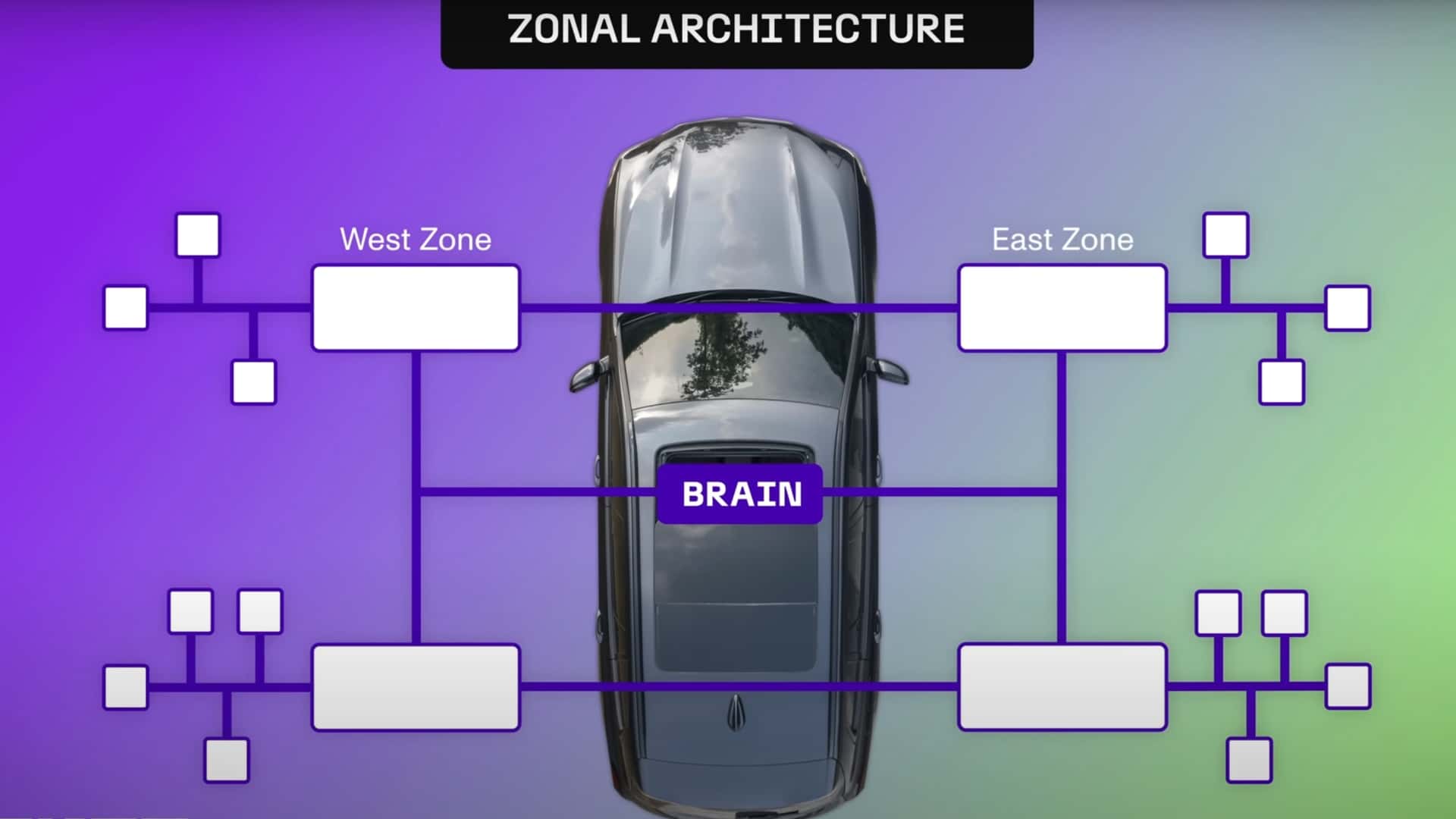
WHY 'ZONAL ARCHITECTURES' ARE THE NEXT BIG THING IN EV DESIGN
It’s the new buzzword in town for software-defined cars. Let us demystify it for you.
When Rivian revealed its second-generation R1 models early this month, the press materials were teeming with technical jargon. “Software stack,” “command centers,” “compute system,” “zonal architecture” and more. How did automakers go from boasting about gas-guzzling engines to drowning their audiences in esoteric Silicon Valley parlance?
The term zonal architecture, however, stuck with us and seems key to the direction in which electric vehicles are headed. We heard it again when Volkswagen announced its investment of up to $5 billion in Rivian. Much of this partnership involves Rivian licensing its “zonal hardware design” with VW and the two collaborating and advancing this tech for future EVs.
If you’re an electrical or software engineer, you’re likely familiar with that term. For most others with a non-engineering background, here's what it means.
Some Basics First
Traditionally, cars have had centralized electrical architectures. They used miles and miles of wiring harnesses connecting various components to a main control unit or the “brain” of the car. The sheer length of these wires and the complexity of the systems made cars heavier and more challenging to service, according to Dutch semiconductor design company NXP.
Older architectures also use separate modules for each function like lighting, infotainment, sensors, etc. That’s inefficient, NXP says.
Now the hardware-first approach is largely outdated. Teslas and many new Chinese EVs have ushered in a sort of role reversal. Carmakers are designing software and then considering how hardware needs to support it, giving birth to what we now commonly call software-designed vehicles (SDVs).
Their performance and various features are heavily integrated and controlled through advanced software, allowing functions such as over-the-air updates, controlling everything via obnoxiously large touchscreens and operating select functions remotely. Rivian says that for SDVs to be efficient and cost-effective, zonal architecture is the way to go.
Zonal Architecture
Rivian Zonal Architecture
“Zonal architectures reduce the amount of wiring harnesses and electronic control units (ECUs) needed in a vehicle by grouping a smaller number of ECUs in different zones of the vehicle,” a Volkswagen spokesperson told InsideEVs.
Rivian’s zonal architecture reduces the number of ECUs from 17 to just seven highly powerful ones. This enabled it to remove 1.6 miles of internal wiring. Consequently, it shaved 44 pounds of weight from its EVs.
Wiring in an electric car is like your body’s central nervous system. It’s an incredibly complex cobweb of cables spanning the entire car. Zonal architectures, however, are more like an office building with multiple departments on different floors responsible for a variety of dedicated tasks.
Tesla was first to market with this tech. S&P said it has a five-year lead over rivals. Thanks to zonal architecture, the Model 3’s wiring was reduced by 50% years ago and it’s the reason why it can be produced in less than half the time compared to rivals. But Tesla’s Chinese and American rivals are finally catching up.
“Instead of organizing hardware compute based on function, these more powerful ECUs now control operations in their general vicinity or zone,” Rivian said.
What does this look like in the real world? The zones are typically defined based on functional requirements, such as powertrain, chassis, body, and infotainment systems. Each ECU is responsible for controlling a specific set of functions within its zone, such as engine control, suspension, lighting, or audio.
The ECUs then communicate over a high-speed network, exchanging information, coordinating actions and responding to varying conditions in real-time.
Let’s assume the car’s cameras, radar and lidar detect an unavoidable object and initiate autonomous emergency braking (AEB). The ADAS system can then trigger a chain reaction of events: the lights start flashing, your seatbelt tightens up, windows get lowered, airbags get ready and the screens display warnings. It's a result of these advanced ECUs communicating with each other.
Benefits Are Huge
Rivian Gen 1 vs Gen 2 ECU Count
On the production line, a zonal system allows increased automation, according to the Society of Automotive Engineers. It’s easier for robots to assemble lighter, less complex wires and help with cost reduction. Most importantly in EVs, it helps improve driving range thanks to weight reduction.
Zonal architectures also allow SDVs to offer subscription services. Heading to the ski resort? Buy a seat heating package. Embarking on a long roadtrip? Get an infotainment package for your passengers. We don't see this often yet, but it's likely to be a possibility in the future.
Above all, the service and maintenance benefits are huge. One Rivian owner told InsideEVs last year that his R1T was out for repairs for almost a year just to replace a tiny side camera damaged in a minor crash. The service center had to yank out the entire wiring harness for that, and in the process, ended up doing more damage to the truck.
With zonal architecture, problems like these will likely never occur. That’s because each zone with control units can independently monitor and diagnose issues within their area. This enables quicker identification of faults, reducing the time needed for diagnostics and service. Service staff would hence also have easier access to individual components should they require quick replacements.
As we’ve seen with Tesla, the learning curve is huge for automakers when it comes to mass deploying advanced tech. Recent studies have shown that EVs still suffer from quality issues, the majority of them tech-related. Things like zonal architectures seem like a step in the right direction, but for customers to witness any tangible benefits, automakers will have to nail it down to a T.
Contact the author: [email protected]
More EV News
2024-07-01T14:24:15Z dg43tfdfdgfd